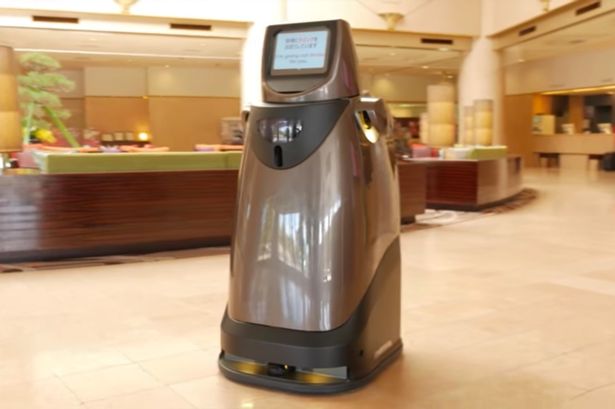Aerospace
Panasonic Robot To Take Jobs At Japan Airport .

Don’t be surprised when you visit a Japanese Airport: Panasonic currently tests its HOSPI(R) Autonomous Delivery Robot by giving it temporary jobs at the Narita International Airport and the ANA Crowne Plaza Narita. Panasonic’s demonstration experiments begun from mid-January 2017.
HOSPI(R) is a robot that can deliver goods autonomously on behalf of humans. Based on preprogrammed map information and using high performance sensors and advanced collision-avoidance algorithm, the robot can move about while staying aware of its surroundings, enabling it to deliver items safely and efficiently without colliding into passersby or various objects along its route.
Panasonic robots to take jobs at airport and hotel in Japan
Unlike traditional delivery systems, equipment does not need to be embedded into the walls or ceilings, and guide tapes do not have to be laid down along the route, so delivery destinations and layout changes to facilities may be easily made and at low cost. Being recognized for these features, the HOSPI(R) has already been adopted by 4 hospitals in Japan and other countries for the delivery of pharmaceuticals and specimens.
In the demonstration experiments to be conducted, the robot will move around the lobby at ANA Crowne Plaza Narita, offering bottled beverages to hotel guests. It will also provide information about bus departures. At „Narita Travel Lounge“ (Narita International Airport) the robot will retrieve used dishware and deliver them to the relevant counter.
Through these demonstration experiments, Panasonic will be verifying the utility of the HOSPI(R) in performing other types of delivery services and accelerating the commercial development of the HOSPI(R). At the moment, there are no plans to introduce the HOSPI(R) to the Narita International Airport and the ANA Crowne Plaza Narita more permanently

Aerospace
Boeing Transfers Rocket Stage to NASA, Paving Way for Human Moon Mission

Boeing has achieved a significant milestone by providing NASA with the second core stage of the Space Launch System (SLS) rocket.
This crucial component, crafted at NASA’s Michoud Assembly Facility (MAF), is set to propel the Artemis II crew into lunar orbit, marking humanity’s return to deep space after a 50-year hiatus.
The monumental Boeing-built rocket stage, the largest element of the Artemis II mission, will embark on a journey aboard the Pegasus barge, traveling 900 miles to NASA’s Kennedy Space Center.
Comparison of two legendary aircraft B777x vs B747 aircraft:Click here
Upon arrival, it will be meticulously integrated with other essential Artemis II components, including the upper stage, solid rocket boosters, and NASA’s Orion spacecraft within the iconic Vehicle Assembly Building. This intricate integration process is a vital step toward the eagerly anticipated Artemis II launch, slated for 2025.
“Boeing-built products helped land humankind on the moon in 1969, and we’re proud to continue that legacy through the Artemis generation,” remarked Dave Dutcher, vice president and program manager for Boeing’s SLS program. “Together, with NASA and our industry partners and suppliers, we are building the world’s most capable rocket and paving the way to deep space through America’s rocket factory in New Orleans.”
NASA, Lockheed Martin Reveal X-59 Quiet Supersonic Aircraft:Click here
The delivery of Core Stage 2 marks a significant achievement in the evolution of the SLS rocket. Towering over 200 feet and powered by four RS-25 engines, this core stage, coupled with two solid-fueled booster rockets, will generate a staggering 8.8 million pounds of thrust. This immense power is crucial to launching Artemis II and future missions into the vast expanse of space.
The SLS rocket stands unparalleled in its capability to transport both crew and substantial cargo to the moon and beyond in a single launch. Its extraordinary capacity will facilitate the delivery of human-rated spacecraft, habitats, and scientific missions to destinations including the moon and Mars, ushering in a new era of space exploration.
-

 Travel1 week ago
Travel1 week agoAir India to Expand US Operations with Three New Routes After a Decade
-

 Travel2 weeks ago
Travel2 weeks agoWhy We Should Avoid These Stamps in a Passport
-

 Airlines1 month ago
Airlines1 month agoInvestigations Reveal Fake Chinese Titanium in Boeing and Airbus Jets
-

 Tech4 weeks ago
Tech4 weeks agoChina’s CATL Plans 1,800-Mile Electric Plane Launch by 2027
-

 Airport3 days ago
Airport3 days agoTop 10 Largest Airports in the World by Size
-

 Aerospace4 weeks ago
Aerospace4 weeks agoChina’s Fighter Jets Turn Wings into Autonomous Drones
-

 Airlines4 days ago
Airlines4 days agoAir India Rolls Out A350s for Delhi-New York JFK and Newark Routes
-

 Defence3 weeks ago
Defence3 weeks agoBoeing Enhances Chinook with New Engines and Block II Upgrades at $96 Million







